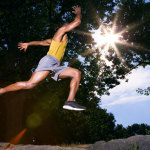Tommy John Surgery: Medial/Ulnar Collateral Ligament Injury and Reconstruction
Last Updated on August 12, 2024 by The SportsMD Editors
The Medial, or ulnar collateral ligament (UCL) of the elbow, is the primary elbow stabilizer to valgus stress within a functional range of motion. It is commonly injured in overhead throwing athletes.
First described in javelin throwers, today it is most commonly injured in baseball pitchers and gymnasts, or with elbow trauma. In overhead throwing athletes, throwing motions may stress the UCL at rates in excess of its ultimate strength. While an injury to the UCL does not always require surgery, in many cases it does. Surgical intervention for a UCL tear is known as Tommy John surgery or UCL reconstruction. Tommy John, a professional baseball pitcher with the Los Angeles Dodgers at the time, was the first person to undergo UCL reconstruction and return to professional sports.
Anatomy of the UCL
The UCL is a band of tissue connecting the two bones (the humerus, or arm bone, and the ulna, the inside bone in the forearm) on the inside or medial part of the elbow. It has three parts, the anterior, posterior and transverse bundles. The anterior bundle carries the majority of the load associated with overhead throwing and is the structure most often injured in throwers. The anterior bundle, running from the sublime tubercle of the ulna to the medial epicondyle of the humerus, is made up of two bands, anterior and posterior.
Function of the UCL?
The UCL functions to resist valgus stress at the elbow, or the forearm, moving in a lateral direction compared to the arm, with the arm in slight elbow flexion. This is the situation found when a thrower moves his arm from the cocked to the acceleration phase of throwing.
Who tears their UCL?
UCL tears affect youth, adolescent and adult athletes in overhead sports including baseball, javelin, tennis, swimming, football, gymnastics, wrestling and volleyball. This injury is becoming increasingly prevalent in our youth athletes to alarming levels. This is most likely related to overuse. Traumatic tears tend to occur in conjunction with elbow dislocations sustained at the time of a fall, or in contact or collision sports.
Causes of UCL injured
While a UCL tear can occur with trauma, it is more often an attritional injury caused by repetitive “microtrauma” leading to symptomatic instability or eventual traumatic rupture of the weakened ligament. This is usually accompanied by a “pop.” It is believed that pitching mechanics and types of pitches thrown may contribute to a UCL tear, however the number of pitches thrown seems to have the greatest effect in gradually weakening the ligament. In a recent study, 76% of patients needing UCL reconstruction had onset of symptoms during a competition, suggesting fatigue may play a role in UCL injury.
What constitutes a tear and how is it diagnosed?
A tear is a disruption of the normal fibers of the ligament. As noted above, a tear can be attritional and caused by microtrauma, or it can be complete as in the case of an acute traumatic rupture or in the case of rupture of a weakened attenuated ligament. Injury to the UCL may lead to elbow instability. In some cases, gapping of the elbow may occur on examination. In other cases, the findings may be more subtle. Physicians trained in the treatment of sports medicine injuries, especially those taking care of overhead athletes, are best suited to diagnose these injuries. Often, radiographs with and without stress views and an MRI with dye injected into the elbow joint are used to confirm the diagnosis.
Prevention of UCL tear
Avoiding overuse is the key to UCL injury prevention, especially in youth athletes. Youth baseball pitchers throwing more than 75 pitches in a game and 600 in a season are more likely to report shoulder or elbow pain. In response, Little League Baseball has put in place pitch count rules to help avoid injury in its pitchers. In general, avoiding throwing when fatigued will likely lessen one’s chance of injury, as the arm muscles actively assist in elbow stability. As they fatigue, more stress is seen by the UCL.
I have medial elbow pain. What else can it be?
Having pain on the inside part of one’s elbow does not always indicate an injury to the UCL. There are many other, more common injuries sustained in the medial elbow or a patient may have combinations of these injuries. A shortlist of other possible injuries causing pain at the medial elbow include: flexor-pronator muscle strain, pronator syndrome, olecranon stress fracture, olecranon spur formation, loose bodies, ulnar neuropathy or cubital tunnel syndrome, and medial epicondylitis (golfer’s elbow).
Conservative treatment for a UCL injury
Conservative treatment includes a period of active rest, followed by physical rehabilitation focused on shoulder and elbow range of motion and strengthening followed by a formal, monitored throwing program. In general, one should undergo a six month period of conservative management for a non-traumatic tear prior to considering surgical intervention. The decision for, and timing of surgical intervention should be tailored to the patient and his or her goals.
When to See the Doctor
Hundreds of athletes sustain acute injuries every day, which can be treated safely at home using the P.R.I.C.E. principle. But if there are signs or symptoms of a serious injury, emergency first aid should be provided while keeping the athlete calm and still until emergency service personnel arrive. Signs of an emergency situation when you should seek care and doctor treatment can include:
- Bone or joint that is clearly deformed or broken
- Severe swelling and/or pain,
- Unsteady breathing or pulse
- Disorientation or confusion
- Paralysis, tingling, or numbness
In addition, an athlete should seek medical care if acute symptoms do not go away after rest and home treatment using the P.R.I.C.E principle.
How do I know if my UCL injury requires surgery?
Consultation with a sports medicine trained orthopaedic surgeon who has an interest in throwing athletes and elbow injuries is suggested if you have medial elbow pain that does not allow you to participate in your desired sports. Based on your consultation you may be indicated for conservative or surgical management based on your individual situation. In general, if you have failed approximately six months of conservative treatment and have a documented injury to your UCL, you may be a candidate for surgical intervention. Many recreational athletes are able to return to play after rehabilitation, while most competitive athletes require surgery to return to their prior level of competition.
Surgical options for UCL reconstruction
Surgical reconstruction of the UCL involves an open surgical procedure on one’s elbow. An elbow arthroscopy may be warranted at the time of surgery based on what additional pathology is present. Based on pre-operative symptoms and/or the technique used, the operating surgeon may decide to move the ulnar nerve to a position of lower tension. The ligament is reconstructed using either a tendon from the patient’s forearm, the palmaris longus, or their leg, the semitendonosis. There are multiple techniques described in the orthopaedic literature for the reconstruction with the two most common being the docking technique and the modified Job, named for Dr. Frank Jobe who performed the first Tommy John procedure in 1974 on Tommy John.
What are the chances of returning to play after Tommy John surgery?
In a recent study of 19 years of patients from Dr. James R. Andrews’ group in Birmingham, AL, 83% of athletes returned to play at or above their previous level at an average of 11.6 months after surgery. This is in line with prior reports ranging from 70-95% return to play at or above previous levels. Most athletes require at least one year to return to play.
Can Telemedicine Help?
Telemedicine is gaining popularity because it can help bring you and the doctor together quicker and more efficiently. It is particularly well suited for sports injuries and facilitating the diagnoses and treatment of those injuries. Learn more about speaking with a sports specialized provider via SportsMD’s 24/7 Telemedicine Service.
References
- Ahmad CS, ElAttrache NS. Elbow valgus instability in the throwing athlete. J Am Acad Orthop Surg. 2006;14(12):693-700.
- Cain EL, Jr., Andrews JR, Dugas JR, et al. Outcome of Ulnar Collateral Ligament Reconstruction of the Elbow in 1281 Athletes: Results in 743 Athletes With Minimum 2-Year Follow-Up. Am J Sports Med. 2010.
- Vitale MA, Ahmad CS. The outcome of elbow ulnar collateral ligament reconstruction in overhead athletes: a systematic review. Am J Sports Med. 2008;36(6):1193-1205.






